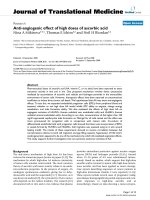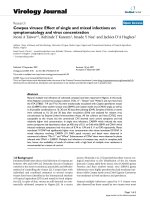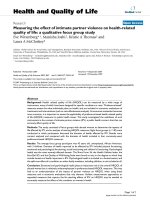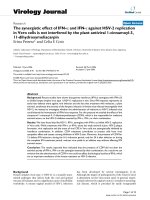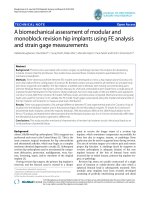Báo cáo hóa học: " Cowpea viruses: Effect of single and mixed infections on symptomatology and virus concentration" ppt
Bạn đang xem bản rút gọn của tài liệu. Xem và tải ngay bản đầy đủ của tài liệu tại đây (248.05 KB, 5 trang )
BioMed Central
Page 1 of 5
(page number not for citation purposes)
Virology Journal
Open Access
Research
Cowpea viruses: Effect of single and mixed infections on
symptomatology and virus concentration
Moni A Taiwo*
1
, Kehinde T Kareem
1
, Imade Y Nsa
1
and Jackies D'A Hughes
2
Address:
1
Dept. of Botany and Microbiology, University of Lagos, Akoka, Lagos, Nigeria and
2
International Institute of Tropical Agriculture,
Ibadan, Nigeria
Email: Moni A Taiwo* - ; Kehinde T Kareem - ; Imade Y Nsa - ;
Jackies D'A Hughes -
* Corresponding author
Abstract
Natural multiple viral infections of cultivated cowpeas have been reported in Nigeria. In this study,
three Nigerian commercial cowpea cultivars ("Olo 11", "Oloyin" and "White") and two lines from
the IITA (IT86D- 719 and TVU 76) were mechanically inoculated with Cowpea aphid-borne mosaic
virus (CABMV), Bean southern mosaic virus (SBMV) and Cowpea mottle virus (CMeV) singly, as well as
in all possible combinations at 10, 20 and 30 days after planting (DAP). Samples of leaves or stems
were collected at 10, 20 and 30 days after inoculation (DAI) and analyzed for relative virus
concentration by Enzyme-Linked Immunosrbent Assay. All the cultivars and lines {CVS/L} were
susceptible to the viruses but the commercial CVS showed more severe symptoms and had
relatively higher viral concentration. In single virus infections, CABMV which induced the most
severe symptoms had absorbance values (at 405 nm) of 0.11 to 0.46 while SBMV and CMeV which
induced moderate symptoms had virus titre of 0.74 to 1.99 and 0.11 to 0.90 respectively. Plants
inoculated 10 DAP had significantly higher virus concentration than those inoculated 30 DAP. In
mixed infections involving CABMV (10 DAP) apical necrosis and death were observed in
commercial cultivars "Olo 11" and "White". Enhancement of CMeV titers were observed in plants
infected with CMeV + CABMV. Multiple viral infections of cowpeas may result in complete yield
loss, hence, the availability of seeds of cultivars with a high level of multiple virus resistance is
recommended as a means of control.
1.0 Background
Estimated yield losses due to viral infection of cowpeas are
between 10% and 100% [1]. Presently, the use of resistant
varieties is the most economical, practicable and effective
method of controlling the viruses [2]. Cowpea lines with
individual and combined resistance to several cowpea
viruses have been identified at the International Institute
of Tropical Agriculture (IITA) and tested for local adapta-
tion [3]. In spite of this, viruses are still detected on com-
mercially cultivated cowpeas in Nigeria [4]. In a recent
survey, Shoyinka et al., [5] reported that there was no eco-
logical restriction to the distribution of the six viruses
detected. Cowpea aphid-borne mosaic virus (CABMV) genus
Potyvirus and Bean southern mosaic virus (SBMV) genus
Sobemovirus were highly prevalent but had moderate inci-
dence while Cowpea mottle virus (CMeV) genus Carmovirus
was moderate in both incidence and prevalence.
Natural multiple infections caused by 4–5 viruses were
also observed but those caused by two viruses were most
Published: 27 September 2007
Virology Journal 2007, 4:95 doi:10.1186/1743-422X-4-95
Received: 10 July 2007
Accepted: 27 September 2007
This article is available from: />© 2007 Taiwo et al; licensee BioMed Central Ltd.
This is an Open Access article distributed under the terms of the Creative Commons Attribution License ( />),
which permits unrestricted use, distribution, and reproduction in any medium, provided the original work is properly cited.
Virology Journal 2007, 4:95 />Page 2 of 5
(page number not for citation purposes)
prevalent [5]. Mixed viral infections have biological, epi-
demiological and economic implications [6,7]. Viruses in
mixed infections may interact synergistically or antagonis-
tically [8-11] causing changes in the concentration of
either or both viruses [12,13] and consequently causing a
new disease [14]. Apart from the synergistic interaction
between CABMV and Cucumber mosaic virus (CMV) genus
Cucu movirus reported by Pio- Ribeiro et al., [14] and the
quantitative and qualitative effects of single and mixed
viral infections on cowpeas [15,16], very limited informa-
tion is available on the interactive effects of mixed viral
infections on cowpeas.
This study was initiated to document the symptoms
induced in three Nigerian commercial cowpea cultivars
and two breeding lines from IITA as a result of single and
mixed inoculations with three cowpea viruses (CABMV,
CMeV, SBMV), establish if symptomatology was corre-
lated with relative virus concentration and ascertain if
there are any interactions between the viruses [17].
2.0 Materials and methods
2.1. Sources of viruses and cowpea cultivars/lines (CVS/L)
One isolate each of CABMV, CMeV and SBMV and the two
cowpea lines (IT86D-719 and TVU 76) used for this inves-
tigation were obtained from IITA. The virus isolates which
were previously stored over CaCl2 at 4°C were propa-
gated and subsequently maintained on cowpea cultivar
"Ife Brown". Seeds of the commercial cowpea cultivars
("Oloyin", "Olo 11" and "White") were obtained from
and confirmed as released varieties at the Federal Ministry
of Agriculture, Moor Plantation, Ibadan. Seeds of the dif-
ferent CVS/L were planted in labeled plastic pots and
maintained in a greenhouse at 28–35°C, at the University
of Lagos.
2.2. Virus treatments
Mechanical inoculations were performed 10 days after
planting (DAP) with the following inocula: CABMV,
CMeV, SBMV, CABMV+CMeV, CABMV+SBMV,
CMeV+SBMV, CABMV+CMeV+SBMV and buffer (con-
trol). The treatments were repeated with other sets of
plants inoculated 20 and 30 DAP between October and
November 2002.
Viral inocula were prepared by grinding systemically
infected leaves from cowpea cultivar "Ife Brown" infected
with individual viruses (1:2 w/v) in a sterilized mortar
with pestle in 0.05 M K2HPO4 pH 7.5. For mixed viral
treatments, saps from the relevant inocula were mixed in
ratio 1:1 (V/V) just before inoculation. The plants were
dusted with Carborundum before inoculation. After inoc-
ulation, the pots were arranged in a randomized complete
block design with three (3) replications. There were three
blocks, each block consisted of 120 plastic pots and repre-
sented the plants inoculated on 10, 20 and 30 DAP. The
pots were kept in a greenhouse that was sprayed weekly
with cypermetrin 10% E.C, and were observed for symp-
toms at 10 days interval until flowering.
2.3. Virus titer determination
Young leaf samples of about the same age were plucked
from the same position and at times stems of dying plants
that received the various treatments at 10, 20 and 30 days
after inoculation (DAI). The samples were kept in grind-
ing pouches (Agdia Inc. Elk. IN, USA) and stored in the
freezer (-4°C), until the end of the experiment. The sam-
ples from the various treatments were weighed on a
weighing balance (Mettler Toledo, Switzerland), ground
in extraction buffer (0.05 M sodium carbonate buffer (pH
9.6) with 2 % (wt/vol) Polyvinylpyrrolidone) and ana-
lyzed by antigen-coated plate enzyme-linked immuno-
sorbent assay (ACP-ELISA) at IITA according to Koenig
[18]. Samples were considered positive when the absorb-
ance value (at 405 nm) were at least twice that of the mean
for the negative control. The average of the absorbance
values (at 405 nm) from the samples taken from plants
that received similar treatments was determined and
recorded.
2.4 Statistical analysis
The statistical package for social scientists (SPSS) was used
for the analysis of the data obtained. Tukey HSD test was
used to determine the level of significance between the
cultivars/lines and virus treatments.
3.0 Results
3.1. Response of Cowpea CVS/L to viral treatments
All the commercial cowpea cultivars and IITA lines used in
this investigation were susceptible to the three viruses.
Systemic symptoms which varied from green-vein band-
ing to mosaic, mottle, internode shortening, apical necro-
sis and reduction in leaf size were induced in plants that
were inoculated singly with CABMV, CMeV or SBMV,
depending on the age of the plant at the time of inocula-
tion (Table 1 - for tables, see Additional file 1). Some of
the cultivars ("Olo 11", "White", TVU 76) that were inoc-
ulated with a mixture of two viruses (CABMV+SBMV or
CABMV+CMeV) at 10 DAP died prematurely while the
other CV/L were stunted with completely reduced leaf size
(Table 1). Plants inoculated with a mixture of the three
viruses 10 DAP also showed severe symptoms resulting in
apical necrosis and reduction in leaf size. On the basis of
the cultivars' response to the viruses in single and mixed
infections, "Olo 11", "White" and TVU 76 appeared to be
more susceptible than "Oloyin".
CABMV was the most aggressive of the three viruses. It
induced the most severe symptoms especially in mixed
infections with CMeV or SBMV at an early stage of growth
Virology Journal 2007, 4:95 />Page 3 of 5
(page number not for citation purposes)
(10 DAP). Most of the plants inoculated at this stage died
prematurely. The plants inoculated at the later stages (20
and 30 DAP) showed mild symptoms only, however,
those that were inoculated with a combination of the
three viruses developed apical necrosis (Fig. 1).
3.2. Virus concentration in plants infected by single viruses
The age of plant at the time of infection as well as the CVS/
L had significant effect on the titer of CABMV in the
infected plants. The concentrations of CABMV in IT86D-
719 when singly infected at 10 and 30 DAP were signifi-
cantly higher than those of TVU 76 while there were no
significant differences between the titres of "White" and
"Oloyin". Absorbance values (at 405 nm) ranging from
0.11 to 0.46 were observed for CABMV. The titer of CMeV
in single virus infection with "oloyin" was significantly
low compared to other CVS/L. However, the concentra-
tions in "Olo 11" were not significantly different from
those of IT86D- 719 and "White" at 10 and 30 DAP
respectively. The absorbance values (at 405 nm) of CMeV
for all CVS/L ranged from 0.11 to 0.90. The titer of SBMV
was very high in all the CVS/L tested with concentrations
ranging from 0.74 to 1.99. Moreso, the titres of SBMV in
IITA lines were significantly lower than those of commer-
cial cultivars (Table 2). Generally, for all the viruses and
CVS/L, absorbance values from plants inoculated 10 DAP
were significantly higher than those from plants inocu-
lated 30 DAP (Table 2).
3.3 Virus titer in mixed infections
In mixed virus infections involving CABMV and CMeV or
SBMV, the concentration of the Potyvirus component
(CABMV) remained virtually unchanged in the different
cowpea CVS/L. Statistically, the concentrations of CABMV
in both single and dual infections were not significantly
different (Tables 3 and 4). In CABMV+CMeV infections,
the ratios of dual/single (CABMV) infections ranged from
0.94 to 1.18 with IT86D-719 having the highest titre while
TVU 76 had the least (Table 3). The concentration of
CMeV in dual infection was significantly higher than in
single infection. Similarly, for CABMV+SBMV infections,
the ratios of dual/single (CABMV) infections ranged from
1.00 to 1.11 (Table 4). However, an enhancement in the
titer of CMeV in CMeV+CABMV infection was observed,
with the ratio of dual/single infections ranging from 1.11
to 3. The enhancement of CMeV titer was most evident in
"Oloyin" (Table 3). There was no evidence of enhance-
ment of the titer of SBMV in SBMV+CABMV infection, as
the ratio of SBMV in dual/single infection varied from 0.7
to 1.54 only (Table 4). In triple virus infections, the three
viruses were detected in all the cowpea CVS/L. Some of the
plants inoculated 10 DAP died prematurely (Table 1).
4.0 Discussion
The results of this study have shown that the three Nige-
rian commercial cultivars (Olo 11, White, Oloyin) used in
this investigation are susceptible to CABMV, CMeV and
SBMV. Owolabi et al., [15] had previously reported the
susceptibility of two other Nigerian commercial cowpea
cultivars to Cowpea mosaic virus genus Comovirus and Black-
eye cowpea mosaic virus genus Potyvirus. In this study, the
commercial cultivars did not only show a more severe
response to the various viral treatments, they also
appeared to have a relatively higher virus concentration
than the IITA breeding lines. This suggests that where
immunity to a cowpea virus cannot be identified, resist-
ance breeding may be enhanced by the determination of
virus titer in the screened plant.
Generally, viral infection of cowpea at an early age
resulted in more severe symptoms, sometimes resulting in
death of the affected plants. This is corroborated in this
investigation, by the higher concentration of the viruses in
plants infected 10 DAP. Such an early infection of cow-
peas during the hot and dry conditions associated with
the dry season may result in complete loss of yield [19]. A
similar observation was reported in field grown cowpeas
in Northern Nigeria by Raheja and Leleji [20]. Also, stud-
ies by Taiwo and Akinjogunla [16] have confirmed that
infection of cowpeas at such an early age of 10 DAP
resulted in a greater reduction in the growth and yield
parameters as well as the nutritive content of the seeds,
compared with those of plants infected at maturity.
In single virus infections, CABMV induced the most severe
symptom of the three viruses but its concentration was
least in most cases. In mixed virus infections involving
CMeV and CABMV, the titer of CMeV was always higher
than its corresponding titer in single infections. This sug-
Apical necrosis induced on plants inoculated with a combina-tion of the three virusesFigure 1
Apical necrosis induced on plants inoculated with a combina-
tion of the three viruses.
Virology Journal 2007, 4:95 />Page 4 of 5
(page number not for citation purposes)
gested some form of synergistic interaction between
CABMV and CMeV. The enhancement in CMeV titer was
detected in all the cultivars although it was more pro-
nounced in two of the commercial CVS ("Oloyin" and
"White"). The synergism observed is further confirmed by
the increased symptoms observed in CVS "Olo 11" and
"White" inoculated with a mixture of CABMV and CMeV.
Potyvirus synergism has been reported by a number of
workers [21,12,22,11]. Anjos et al., [9], showed that Soy-
bean mosaic virus (SMV) genus Potyvirus interacted syner-
gistically with some comoviruses, but two other
potyviruses, Bean yellow mosaic virus and Peanut mottle virus
did not, suggesting that not all potyviruses are involved in
the synergistic interaction.
In these interactions, the concentration of the Potyvirus
member remained unchanged while the concentration of
the non-Potyvirus member increased significantly, in the
dually infected plants [9,11]. A number of mechanisms
have been proposed for the synergism between comovi-
ruses and potyviruses. These include the ability of the
comoviruses to utilize the replication machinery of the
Potyvirus (SMV) for their multiplication, since the two
groups have been shown to share some amino acid
sequences [23,24]. Also, the SMV enclosed movement
protein has been implicated in enhancing the transporta-
tion of the Comovirus and by so doing increasing the
number of infected cells in dually infected plants [9].
Although CMeV belongs to the genus Carmovirus, it has
isometric particles like the comoviruses. The mechanism
for the enhancement of its titer needs to be determined as
there are no previous reports of such interactions, or sim-
ilarity in genomes of potyviruses and carmoviruses. Inter-
estingly, the titer of SBMV, another isometric virus was not
enhanced by CABMV during this investigation.
These results confirm the susceptibility of Nigeria's com-
mercial cowpea cultivars to viral infections, in spite of sev-
eral reports on the availability of sources of resistance to
the viruses [3,4,2]. Early infection of the cultivars by mul-
tiple viruses especially with CABMV may result in com-
plete loss in yield. The implication of this result is that
either the rate of acceptance and utilization of resistant
varieties in Nigeria is poor or new resistance breaking
strains of the viruses have evolved. There is a need to
intensify efforts at continuously monitoring the predomi-
nant field virus strains, and developing advanced cowpea
breeding lines/CVS with multiple resistance to the eco-
nomically important viruses. The seeds of the resistant
cultivars should possess horticultural and culinary desira-
ble traits, and should be readily available to growers, in
order to minimize losses due to viral infections. There
may also be the need to explore other control strategies
such as pathogen-derived resistance in the management
of cowpea viruses. The modern concept of production of
transgenic plants that has been applied to tobacco and
papaya [25,26] may have to be adapted to cowpea, for
effective virus control and sustenance of the nation's lead
in cowpea production.
Additional material
Acknowledgements
We thank Obi Nzenkwe and Iyabo Adenrele for excellent technical assist-
ance.
References
1. Rachie KO: Introduction. In Cowpea research, production and utiliza-
tion Edited by: Singh SR, Rachie KO. John Wiley and Sons, Chichester,
U.K.; 1985:xxi-xxviii.
2. Taiwo MA: Viruses infecting legumes in Nigeria: case history.
In Plant Virology in Sub-Saharan Africa Edited by: Hughes J d'A, Odu, B.
Proceedings of a conference organized by IITA, Ibadan, Nigeria;
2003:93-115.
3. Thottappilly G, Rossel HW: Virus diseases of cowpea in tropical
Africa. Tropical Pest Management 1992, 38(4):337-348.
4. Huguenots C, Furneaux MT, Thottappilly G, Rossel HW, Hamilton RI:
Evidence that Cowpea aphid- borne mosaic and Blackeye cow-
pea mosaic viruses are two different potyviruses. J Gen Virol
1993, 74:335-340.
5. Shoyinka SA, Thottappilly G, Adebayo GG, Anno-Nyako FO: Survey
on cowpea virus incidence and distribution in Nigeria. Inter-
national J of pest management 1997, 43(2):127-132.
6. Rochow WF: The role of mixed infections in the transmission
of plant viruses by aphids. Annu Rev Phytopathol 1972, 10:101-125.
7. Ford RE, Goodman RM: Epidemiology of soybean viruses. In
World Soybean Res Conf 1975 Edited by: Hill LD. Interstate Printers
and Publishers, Danville, IL; 1976:501-512.
8. Kassanis B: Interaction of viruses in plants. Adv Virus Res 1963,
10:219-255.
9. Anjos JR, Jarlfors U, Ghabrial SA: Soybean mosaic Potyvirus
enhances the titer of two Comoviruses in dually infected soy-
bean plants. Phytopathology 1992, 82:1022-1027.
10. Vance VB, Berger PH, Carrington JC, Hunt AG, Shi XM: 5 proximal
potyviral sequences mediate potato X potyviral synergistic
disease in transgenic tobacco. Virology 1995, 206:583-590.
11. Murphy JF, Bowen KL: Synergistic disease in pepper caused by
the mixed infection of Cucumber mosaic virus and Pepper mot-
tle virus. Phytopathology 2006, 96:240-247.
12. Calvert LA, Ghabrial SA: Enhancement by Soybean mosaic virus
of Bean pod mottle virus titer in doubly infected soybean. Phy-
topathology 1983, 73:992-997.
13. Goldberg K, Brakke KM: Concentration of Maize chlorotic mot-
tle virus increased in mixed infections with maize dwarf
mosaic virus, strain B. Phytopathology 1987, 77:162-167.
14. Pio-Ribeiro G, Wyatt SD, Kuhn CW: Cowpea stunt: a disease
caused by the synergistic interaction of two viruses. Phytopa-
thology 1978, 68:1260-1265.
15. Owolabi AT, Taiwo MA, Mabadeje SA: Effects of single and mixed
inoculations with Blackeye cowpea mosaic and Cowpea mosaic
viruses on two Nigerian cowpea cultivars. Nigerian J of Basic and
Applied Sci 1988, 2:25-33.
16. Taiwo MA, Akinjogunla OJ: Cowpea viruses: Quantitative and
Qualitative effects of single and mixed viral infections. African
J of Biotech 2006, 5(19):1749-1756.
Additional File 1
Cowpea virus tables
[ />422X-4-95-S1.doc]
Publish with BioMed Central and every
scientist can read your work free of charge
"BioMed Central will be the most significant development for
disseminating the results of biomedical research in our lifetime."
Sir Paul Nurse, Cancer Research UK
Your research papers will be:
available free of charge to the entire biomedical community
peer reviewed and published immediately upon acceptance
cited in PubMed and archived on PubMed Central
yours — you keep the copyright
Submit your manuscript here:
/>BioMedcentral
Virology Journal 2007, 4:95 />Page 5 of 5
(page number not for citation purposes)
17. Taiwo MA, Apampa K, Hughes d'A J, Nsa IY: Cowpea viruses:
Effect of single and mixed infections on symptomatology and
virus concentration. Phytopathology 2006, 96:S112. abstr.
18. Koenig R: Indirect ELISA methods for the broad specificity
detection of plant viruses. J Gen Virol 1981, 55:53-62.
19. Kareem KT, Taiwo MA: Interactions of viruses in cowpea:
effects on growth and yield parameters. Virology J 2007,
4:15-21.
20. Raheja AK, Leleji OI: An aphid-borne virus disease of irrigated
cowpea in northern Nigeria. Plant Dis Rep 1974, 58:1080-1084.
21. Ross JP: Effect of single and double infections of Soybean
mosaic and Bean pod mottle viruses on soybean yield and seed
character. Plant Dis Rep 1968, 52:344-348.
22. Wang Y, Gaba V, Yang J, Palukaitis P, Gal-on A: Characterization
of synergy between Cucumber mosaic virus and potyviruses in
cucurbit hosts. Phytopathology 2002, 92:51-58.
23. Domier L, Shaw JG, Rhoads RE: Potyviral proteins share amino
acids homology with picorna-, como-, and caulimoviral pro-
teins. Virology 1987, 158:20-27.
24. Goldbach R: Genome similarities between plant and animal
RNA viruses. Microbiol Sci 1987, 4:197-202.
25. Powell-Abel P, Nelson RS, De B, Hoffmann N, Roggers SG, Fraley RT,
Beachy RN: Delay of disease development in transgenic plants
that express the Tobacco mosaic virus coat protein gene. Sci-
ence 1986, 232:738-742.
26. Bau HJ, Cheng YH, Yang JS, Yeh SD: Broad spectrum resistance
to different geographic strains of Papaya ringspot virus in coat
protein transgenic Papaya. Phytopathology 2003, 93:112-120.
